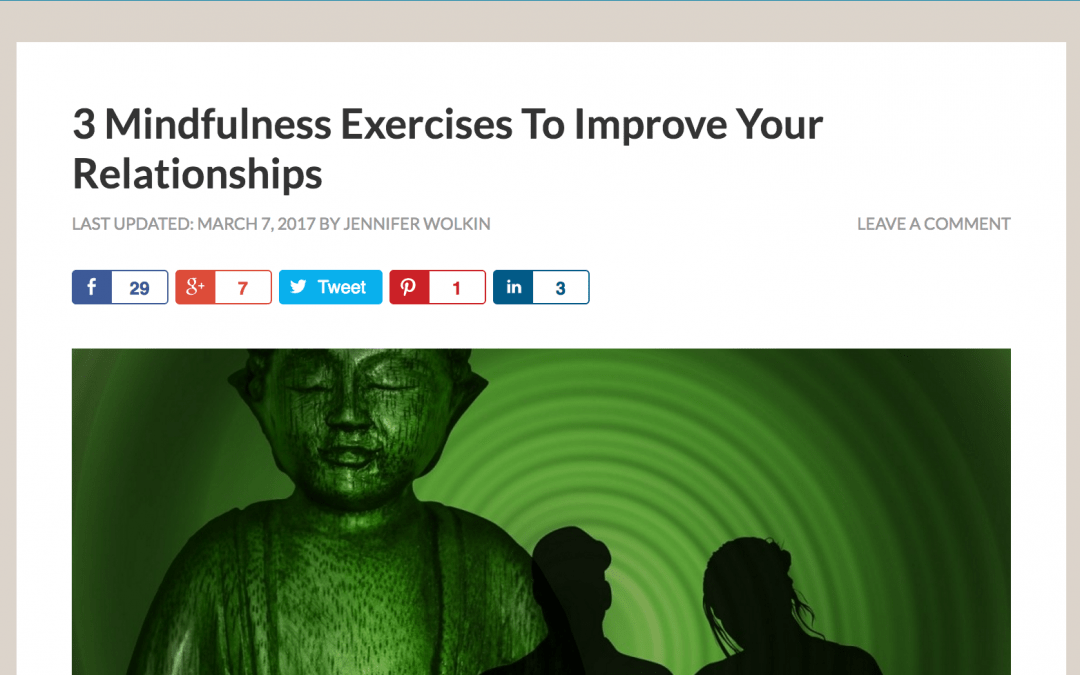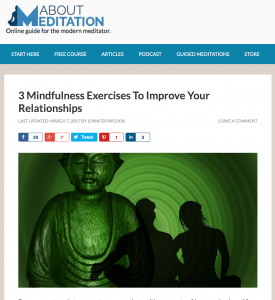
Repost: April Showers Bring Poetry Pitter Patters: My Favorite Poems and Why They Resonate
This blog post originally appeared on The Huffington Post
It’s April, and while that means more rain showers, it also means it’s time to recognize a literary style “in which special intensity is given to the expression of feelings and ideas by the use of distinctive style and rhythm”. Or, simply put, poetry!
In honor of National Poetry Month, I would like to present these 4 poems that not only resonate deeply with me, but have also helped to inform my work with my clients.
 One of the beauties of poetry, I think, is that there is no single meaning to any one poem. The poet pens a narrative in verse that can be interpreted in all ways; I would even go so far as to say that a reader of poetry projects upon a poem what he/she needs in that given moment. The interpretation is never static, and likely the reader will experience something different with each reading or recitation. So, if it stirs something within you right now – and moves you to greater awareness of self, others, and the world – then honor those things!
One of the beauties of poetry, I think, is that there is no single meaning to any one poem. The poet pens a narrative in verse that can be interpreted in all ways; I would even go so far as to say that a reader of poetry projects upon a poem what he/she needs in that given moment. The interpretation is never static, and likely the reader will experience something different with each reading or recitation. So, if it stirs something within you right now – and moves you to greater awareness of self, others, and the world – then honor those things!
Vulnerable alert: These works have seen me through difficult times. As my post-doc and a romantic relationship were both simultaneously coming to an end in 2010, the feeling of loss led me to these poems. I recited them every time I needed a reminder that not only was it was okay to feel every iteration of my feelings, but that those feelings were also healthy, and important – serving as a springboard for new endeavors and a greater openness to identifying, and then saying yes to, those things I desired that were beyond my comfort zone.
Reciting the poems, as I power-walked around the Charles River, comforted me, and also allowed me to notice and feel the pain of confronting the changes in my life. The more I recited, the more I let myself feel, and the more facile it became to just put one foot in front of another, trusting that those small steps would lead me to my somewhere new. The words reverberated over and over until I found my way towards healing.
There is much to be learned from a poetic journey inward. I hope that one, or more, of these poems bring you some of the peace that they have brought me.
1. The Journey
by Mary Oliver
One day you finally knew
what you had to do, and began,
though the voices around you
kept shouting
their bad advice—
though the whole house
began to tremble
and you felt the old tug
at your ankles.
“Mend my life!”
each voice cried.
But you didn’t stop.
You knew what you had to do,
though the wind pried
with its stiff fingers
at the very foundations,
though their melancholy
was terrible.
It was already late
enough, and a wild night,
and the road full of fallen
branches and stones.
But little by little,
as you left their voices behind,
the stars began to burn
through the sheets of clouds,
and there was a new voice
which you slowly
recognized as your own,
that kept you company
as you strode deeper and deeper
into the world,
determined to do
the only thing you could do—
determined to save
the only life you could save.
Why it resonates:
The Journey resonates with me because it speaks to the idea of individuation and separation.
It is hard for most of us to leave our family of origin, mentally speaking. It’s a challenge to go out into the world, without the protection and grounded-ness that our primary attachment figures provided (if we were lucky enough) when we were younger. It is also just as hard, because despite wanting to “become ourselves” as individual entities, we often stay enmeshed in the maladaptive patterns of our ancestry. Their traumas, and subsequent triggers, sometimes become ours, and though we want to shed those layers from our own psyches, it is what we know – the familiarity is resoundingly comforting.
My clients and I have learned that we sometimes make unconscious agreements with ourselves to hold on to the pain, until we realize we can’t breathe from the bearing of it, and we need to let go of it in order to save ourselves.
2. Autobiography in Five Chapters
by Portia Nelson
I
I walk down the street.
There is a deep hole in the sidewalk
I fall in.
I am lost…
I am hopeless.
It isn’t my fault.
It takes forever to find a way out.
II
I walk down the same street.
There is a deep hole in the sidewalk.
I pretend I don’t see it.
I fall in again.
I can’t believe I’m in the same place.
But it isn’t my fault.
It still takes a long time to get out.
III
I walk down the same street.
There is a deep hole in the sidewalk.
I see it is there.
I still fall in…it’s a habit
My eyes are open; I know where I am;
It is my fault.
I get out immediately.
IV
I walk down the same street.
There is a deep hole in the sidewalk.
I walk around it.
V
I walk down another street.
Why it resonates:
Both personally and professionally I know so well that change is hard. Actually, that’s the understatement of the day! When we have engaged with certain unhealthy thoughts, feelings, and behaviors for a long time, the path towards wellness takes extra patience, perseverance, time, and trust. This poem resonates for me because it reflects a sequence of change that is authentic.
Portia beings by speaking to the deeply painful reckoning with bumps in the road. Then, she begins to recognize patterns that might be holding her back, but does so with a gentle nudge and compassion for herself. She continues by putting just one step in front of the other, supporting herself through each step, not blind to the challenges, but not beating herself up either for the slow progress, which includes literally falling into the same old maladaptive patterns.
She recognizes that patterns are like habits, accumulations of ways of being and showing up in a world that used to work for us, and that most likely previously protected us from our pain. Ultimately, she finds a new path. This doesn’t mean her journey is over. In fact, in some ways, it has just begun.
3. The Guest House
by Rumi
This being human is a guest house.
Every morning a new arrival.
A joy, a depression, a meanness,
some momentary awareness comes
As an unexpected visitor.
Welcome and entertain them all!
Even if they’re a crowd of sorrows,
who violently sweep your house
empty of its furniture,
still treat each guest honorably.
He may be clearing you out
for some new delight.
The dark thought, the shame, the malice,
meet them at the door laughing,
and invite them in.
Be grateful for whoever comes,
because each has been sent
as a guide from beyond.
Why it resonates:
Rumi, the Sufi poet, waxed poetic in his ‘The Guest House’ a long time ago about how we should treat every emotion as a visitor, without looking to get rid of any of them, but rather to understand their message and purpose.
Emotions are neither inherently good nor bad, and to think of them in such dichotomous terms is to do oneself a disservice. Emotions just are. In fact, every emotion tells us something about our inner experience that might be informing our outer experience.
What Rumi alluded to in his writing was also recently confirmed by research (http://www.scientificamerican.com/article/negative-emotions-key-well-being/) – which indicated that well-being is actually predicated on having a wider range of emotions, including the negative ones! Yes, that’s correct, the more you can feel, in all of feeling’s iterations, the better off you are.
While relaxation is a beneficial byproduct of mindfulness practice, its salutary effects are associated with the ability to help us expose ourselves to our emotions, to truly feel them, with compassion and as little judgment as possible. That’s why techniques like mindfulness have gained anecdotal significance, and their effectiveness is being confirmed through rigorous research.
4. Wild Geese
by Mary Oliver
You do not have to be good.
You do not have to walk on your knees
For a hundred miles through the desert, repenting.
You only have to let the soft animal of your body
love what it loves.
Tell me about your despair, yours, and I will tell you mine.
Meanwhile the world goes on.
Meanwhile the sun and the clear pebbles of the rain
are moving across the landscapes,
over the prairies and the deep trees,
the mountains and the rivers.
Meanwhile the wild geese, high in the clean blue air,
are heading home again.
Whoever you are, no matter how lonely,
the world offers itself to your imagination,
calls to you like the wild geese, harsh and exciting —
over and over announcing your place
in the family of things.
Why it resonates:
We are socialized from a young age to think that being “good” means that we will be rewarded. What does “good” really mean though? The need to “be good” for the sake of approval, or the idea that one needs to repent to be redeemed, is immediately refuted here. How do we differentiate our own moral compass, and being a “good” person versus a “bad” person, from how other people interpret “good” and “bad”? When we try to base our actions on other people’s definitions, it can often lead to stifling expectations and guilt, which leads to deep suffering.
This poem, perhaps, then, speaks to a freedom that defies the need to be “good” as a way out of punishment or scorn by others. In this poem, Mary Oliver invites us to shed the shackles we so often place upon ourselves for the sake of pleasing others. She makes room for us to let go of that, to fully embrace our essence, without judging it, without labeling it good or bad or right or wrong.
There is a chance for catharsis here, as we let ourselves connect to the “soft animals of our body”. Beyond the layers of somatic tension, clenching, and a protective posturing, is softness. The soft part of ourselves doesn’t need to hide. We shouldn’t deny what we love or whom we love or how we love.
To me, the most poignant part of this poem is the invitation to shed those limiting layers, and to look at the bigger and grander picture; that is, all of us, every living creature, are immortally bound by our smallness and bigness all at once. Perhaps, this collective truth is the most healing of them all.

You may have noticed that two of the poems I shared are from Mary Oliver’s oeuvre. I tried to be more diverse in my choices, but Mary has become a role model and mentor (read-she doesn’t know who I am!) for me in my own journey as a poet. A few years ago I attended one of Mary Oliver’s rare readings and signings at the 92nd Street Y and scored this!
Buy more of Mary Oliver’s poetry here
~
Sometimes the only way out of a trying situation or time in our life, is to journey inward, and a great place to start is by peering into a poet’s own journey. I hope that one, or more, of these poems bring you some of the peace that they have brought me.






